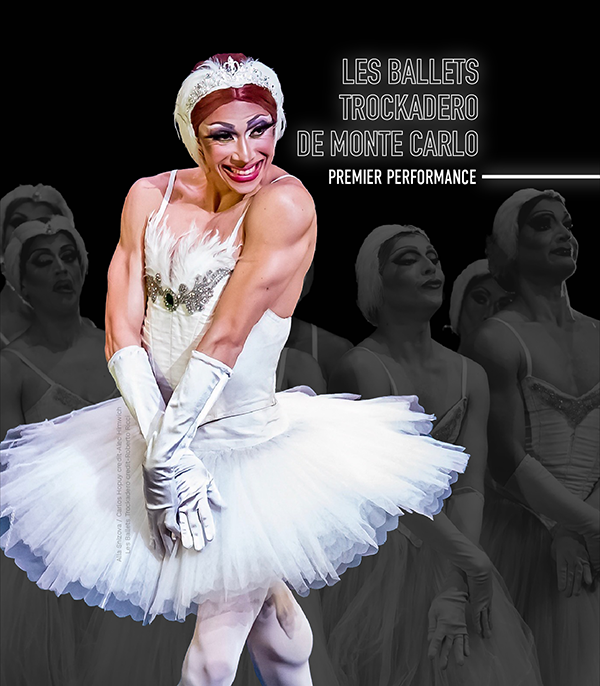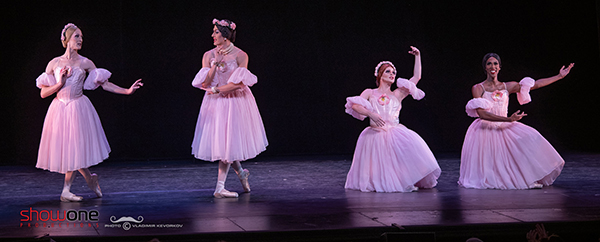
FEATURING
Colette Adae Sascha Altschmerz
Ludmila Beaulemova Varvara Bratchikova
Maria Clubfoot Nadia Doumiafeyva
Helen Highwaters Elvira Khababgallina
Varvara Laptopova Grunya Protozova
Eugenia Repelskii Olga Supphozova
Maya Thickenthighya Minnie van Driver
Sascha Altschmerz Jacques d’Aniels
Boris Dumbkopf Nicholas Khachafallenjar
Dmitri Legupski Marat Legupski
Sergey Legupski Timur Legupski
Vladimir Legupski Yuri Smirnov
Kravlji Snepek William Vanilla
Jens Witzelsucht Tino Xirau-Lopez
| Artistic Director Tory Dobrin |
Associate Director Isabel Martinez Rivera |
Managing Director Liz Harler |
Make up provided by

The official Pointe Shoe Provider of
Les Ballets Trockadero de Monte Carlo
Program subject to change without notice.
LE LAC DES CYGNES
(SWAN LAKE, ACT II)
MUSIC BY
PYOTR ILYICH TCHAIKOVSKY
CHOREOGRAPHY AFTER
LEV IVANOVICH IVANOV
COSTUMES BY
MIKE GONZALES
DECOR BY
CLIO YOUNG
LIGHTING BY
KIP MARSH

Swan photo by Emma Kauldhar
Swept up into the magical realm of swans (and birds), this elegiac phantasmagoria of variations and ensembles in line and music is the signature work of Les Ballets Trockadero. The story of Odette, the beautiful princess turned into a swan by the evil sorcerer, and how she is nearly saved by the love of Prince Siegfried, was not so unusual a theme when Tchaikovsky first wrote his ballet in 1877 — the metamorphosis of mortals to birds and visa versa occurs frequently in Russian folklore. The original Swan Lake at the Bolshoi Theatre in Moscow was treated unsuccessfully; a year after Tchaikovsky's death in 1893, the St. Petersburg Maryinsky Ballet produced the version we know today. Perhaps the world's best known ballet, its appeal seems to stem from the mysterious and pathetic qualities of the heroine juxtaposed with the canonized glamour of 19th century Russian ballet.
Benno: Mikhail Mypansarov
(friend and confidant to)
Prince Siegfried: Vladimir Legupski
(who falls in love with)
Nadia Doumiafeyva (Queen of the)
Swans:
Colette Adae, Sascha Altschmerz, Varvara Bratchikova, Maria Clubfoot, Minnie van Driver, Elvira Khababgallina, Grunya Protazova, Maya Thickenthighya
(all of whom got this way because of)
Von Rothbart: Yuri Smirnov
(an evil wizard who goes about turning girls into swans)
~ INTERMISSION ~
PAS DE DEUX OR MODERN WORK TO BE ANNOUNCED.
LE GRAND PAS DE QUATRE
MUSIC BY
CESARE PUGNI
CHOREOGRAPHY AFTER
JULES PERROT
COSTUMES BY
MIKE GONZALES
DECOR AND LIGHTING BY
KIP MARSH

Photo by Vladimir Kevorkov
It was the idea of Mr. Benjamin Lumley, manager of her Majesty's Theatre in London, to stage a grand divertissement, bringing together the four greatest ballerinas of the romantic age. Through the most delicate diplomacy, he managed to call the celebrated ladies to London, but not, however, without several "artistic misunderstandings." One of these was the choice of who was to receive the favored last variation, each lady certain of her own supremacy. Tactfully, Mr. Lumley offered it to the oldest among them; it is said Madame Taglioni stood quite still while the younger women demurely stepped back. The Gala Divertissement finally took place on June 26, 1845. The choreography was fashioned by Jules Perrot--one English wag likened his task to teaching lions and tigers to waltz in a cage. Mr. Perrot sought to exploit the signature qualities of each danseuse: Grahn's vivaciousness, Grisi's lyrical expressiveness, Cerrito's coquetry, and Taglioni's ethereal mystery. The original Pas de Quatre was danced only four times (Queen Victoria and Prince Albert attended the third performance), but it has served as a model for the ritualistic celebrations of academic dance we now call "abstract ballet." It survives today as one of the most charming (and silly) evocations of Romantic Ballet in the 1840s.
Lucille Grahn
Ludmila Beaulemova
Carlotta Grisi
Minnie van Driver
Fanny Cerrito
Helen Highwaters
Marie Taglioni
Eugenia Repelski
~ INTERMISSION ~
GO FOR BAROCCO
MUSIC BY
J.S. BACH
CHOREOGRAPHY BY
PETER ANASTOS
COSTUMES BY
MIKE GONZALES
LIGHTING BY
KIP MARSH

Photo by Alec Himwich
Stylistic heir to Balanchine's Middle-Blue-Verging-On-Black-and-White Period, this ballet has become a primer in identifying stark coolness and choreosymphonic delineation in the new(neo) neo-new classic dance. It has been called a wristwatch for Balanchine clock-time.
First Movement (Moderato)
Eugenia Repelskii and Helen Highwaters
with
Minnie van Driver, Ludmila Beaulemova, Maria Clubfoot, Grunya Protazova
Second Movement (Adagio)
Eugenia Repelskii and Helen Highwaters
Third Movement (Allegro)
ALL
is a nonprofit dance company chartered by the State of New York. Martha Cooper, president; Jenny Palmer, vice-president; Tory Dobrin, secretary/treasurer.
James C.P. Berry, Amy Minter
All contributions are tax-deductible
as provided by law.
instagram! @lesballetstrockadero
Tweet us! @TrocksB
The Howard Gilman Foundation
Mertz Gilmore Foundation
The Max and Victoria Dreyfus foundation
Rallis Foundation
Shubert Foundation
This project is supported in part by an award from the National Endowment for the Arts.
Thanks to our local and state cultural funding agencies for their contributions to our work in New York with support, in part, by public funds from the New York City Department of Cultural Affairs in partnership with the City Council; the New York State Council on the Arts with the support of the Office of the Governor and the New York State Legislature; The Harkness Foundation for Dance; and the NYU Community Fund.
Thanks to our Board of Directors and individual supporters for their generous contributions that make our nonprofit mission possible.
Music for Swan Lake, Pas de Quatre and Go for Barocco is conducted by Pierre Michel Durand with the Czech Philharmonic Chamber Orchestra, Pavel Prantl, Leader
BOOKING INQUIRIES:
Liz Harler
Managing Director
liz@trockadero.org




